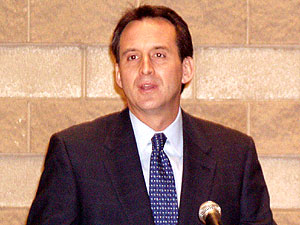Audio
Photos
Respond to this story
| |||||||||||||||||||||
Pawlenty administration forges health care alliance
November 29, 2004
 |
| Gov. Pawlenty announced Monday that state government would team with business groups, labor interests and others in a new alliance to negotiate better prices on health care. (MPR Photo/Tom Scheck) |
St. Paul, Minn. — Pawlenty's idea is based on the same economic theory that gives large, national retailers an advantage over smaller competitors. For example, Wal-Mart can sell a widget at a lower price than a mom-and-pop neighborhood store because Wal-Mart buys widgets in bulk to stock every one of its stores. Wal-Mart officials know that suppliers are eager to do business with them, so they're in a better place to negotiate a lower price than the neighborhood store.
Pawlenty hopes that an alliance that combines people enrolled in the state's subsidized health insurance programs, employees with the state's large companies and the state's workforce will hold similar sway. He says the state's HMOs have tried to lower costs in the last decade but haven't been as effective as he would like.
 | |||
"It's been uncoordinated," he said. "It's been somewhat disjointed. It's been fragmented and it's happened slowly. This brings the thundering power of three-fifths of the marketplace to bear on to these demands and says on behalf of three-fifths of the marketplace in the state, these are the changes that we expect."
The health care alliance is one of several ideas that Pawlenty's health care cabinet came up with earlier this year.
Members of the alliance were careful to say that it would not be a government-run purchasing pool. They say it's a loosely-knit group that hopes that their numbers can induce changes to both cost and quality.
Carolyn Pare, with the Buyer's Health Care Action Group, says high quality health care isn't always the most expensive. She says the group supports creating a best-in-class certification so consumers know which providers are doing a good job.
"We know cost and quality can improve in tandem as providers prevent errors, boost efficiency and develop expertise. We have also learned in many businesses, and in government that doing it right the first time not only improves outcomes but also lowers cost," she said.
The group also hopes to eliminate some state regulations and paperwork to make things easier on health care providers. It also calls on hospitals and doctors to reduce their own paperwork by adopting a system for storing patient files electronically.
The Minnesota Medical Association's Michael Gonzalez Campoy supports the ideas of streamlining services and reducing government paperwork. But he says the MMA is uncomfortable with provider rankings since doctors treat patients under different circumstances.
"Who gets to determine what centers for excellence are and how does this effect those physicians who by necessity or by choice are serving patients that are underserved with poorer financial resources where the quality of care isn't going to be as good as other places?" he said.
Neither Pawlenty nor anyone else would give a dollar amount on how much these proposals would save the state and employers. Pawlenty estimates improved treatment, streamlining paperwork and improving technology could save between 30 to 40 percent of the health care dollar.
But some question those estimates. Health care costs have been increasing at double digit rates in recent years. Alan Baumgarten, a private analyst who studies the health care marketplace, says the proposed changes could help slow the rate of increase, but probably not lower costs. "The fact that state government and employers are lining up and saying 'this is something we're making a commitment to' that's great and we'll probably see some very positive results from it. But, again, people should have realistic expectations about what can be accomplished," Baumgarten said.
Pawlenty can implement many of the proposals without the Legislature's approval. Pawlenty says he will recommend other health care changes to the Legislature. He supports state adoption of health savings accounts. Those accounts would allow individuals or employers to contribute tax free funds to a plan that can be used for health insurance.
|
News Headlines
|
Related Subjects
|

